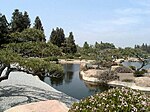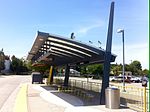Tillman Water Reclamation Plant

The Donald C. Tillman Water Reclamation Plant is a water reclamation plant located in Van Nuys, Los Angeles, Southern California, US. The plant was conceived of, designed and constructed by the City of Los Angeles' Bureau of Engineering. The Administration Building was designed by California architect Anthony J Lumsden. It is home to The Japanese Garden, which has been used as a backdrop in films and TV, including Bio-Dome, and Starfleet Academy from Star Trek.The facility treats and reclaims wastewater, removing it from the sewer system and reducing the need for large sewer pipes downstream from the plant. The treated water is discharged to the lake in the adjacent Balboa Park, and then flows into the Los Angeles River where it comprises the majority of the flow. The plant began operation in 1985 and processes 80 million US gallons (300,000 m3) of waste a day, producing 26 million US gallons (98,000 m3) of recycled water. It is named after Donald C. Tillman, the city engineer from 1972 to 1980.
Excerpt from the Wikipedia article Tillman Water Reclamation Plant (License: CC BY-SA 3.0, Authors, Images).Tillman Water Reclamation Plant
Woodley Avenue, Los Angeles
Geographical coordinates (GPS) Address External links Nearby Places Show on map
Geographical coordinates (GPS)
| Latitude | Longitude |
|---|---|
| N 34.1835 ° | E -118.479 ° |
Address
Tillman Water Reclamation Plant
Woodley Avenue
91411 Los Angeles
California, United States
Open on Google Maps











